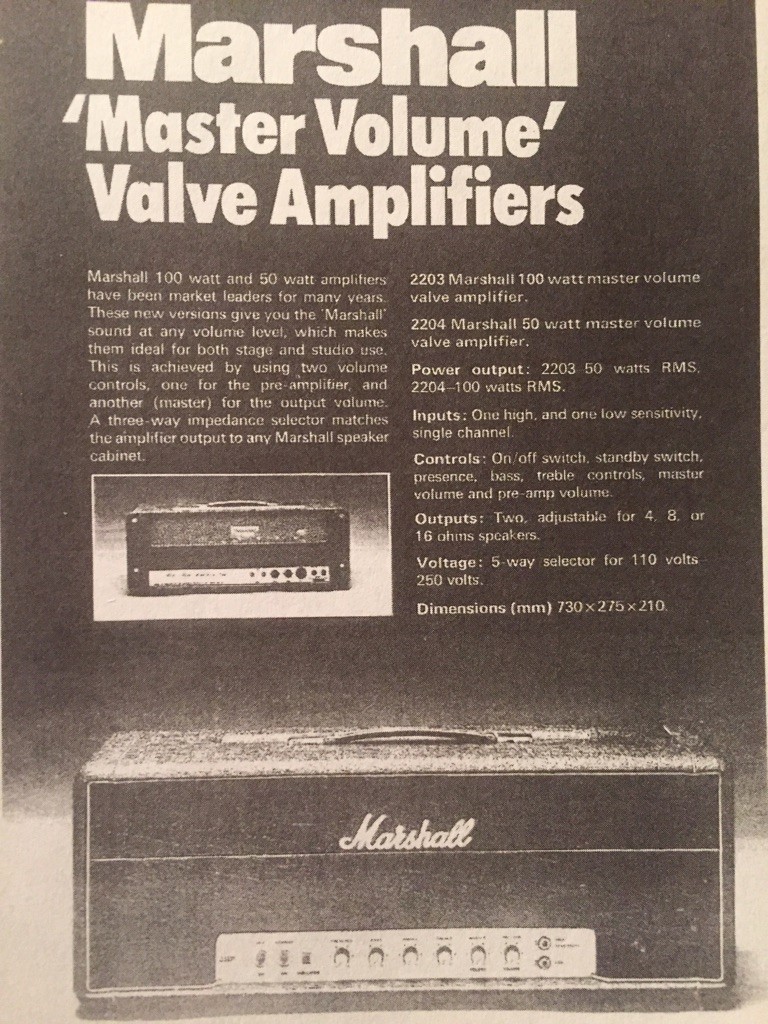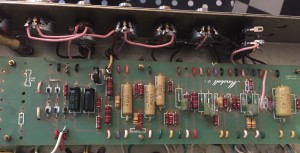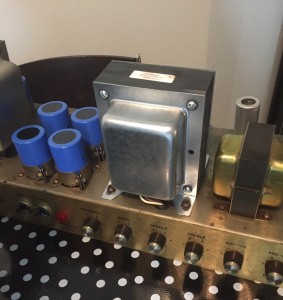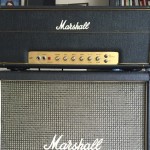When people most often think of vintage Marshalls, the most highly regarded are the non-master volume series including the model 1959 100 watt head produced in the late 1960’s and early 1970’s. It’s hard to argue against the amp that Hendrix, Page, Van Halen, Clapton and many others used.
And while I would agree that they are incredible amps, the REAL game changer in my mind for Marshall was when the company introduced its master volume series of amps in 1976. The models 2203 (100 watts) and 2204 (50 watts) heads became instant hits, and quickly began to outsell the non-master volume versions by the late 70’s. Why? Well, they sounded great at more reasonable volumes which essentially made them more practical for guitarists who couldn’t always play at full volume and crank up a non-master volume Marshall inside a concert arena.
The sound of a master volume Marshall is different since it relies on gain and distortion emphasis produced by the preamp stage and less so on the compression character created by the output tubes when turned up. But the volume in these amps is manageable and this is what musicians of the time needed when playing the clubs and bars of the day. In that respect, nothing’s changed and musicians today still need to have control over their levels.
A 2203 Marshall half stack with a Gibson plugged in provides a fantastic driving rock and roll distortion tone with punch. It has sustain with mids and highs that cut through the mix – perfect in a band setting. And the amp, when needing just a bit more gain, takes  very kindly to overdrive and boost pedals for those searing leads. Just like the model 1959 that preceded it, the 2203 is a model of basic but great tube tone. Want to tame the overdrive and clean up the signal? Just roll down your guitar’s volume knob. It’s old-school amp simplicity at its finest.
very kindly to overdrive and boost pedals for those searing leads. Just like the model 1959 that preceded it, the 2203 is a model of basic but great tube tone. Want to tame the overdrive and clean up the signal? Just roll down your guitar’s volume knob. It’s old-school amp simplicity at its finest.
The difference in volume between the 100 watt and 50 watt models is really negligible. The 50 watt 2204 was and is still a loud amplifier. But the feel of it is different as it tends to compress more while the 100 watt 2203 is bolder, with more punch and clarity. It’s all a matter of personal preference when comparing the two. I’ve always preferred the 100 watt models myself.
The circuits used in these master volume series Marshalls were actually very similar to the non-master volume amps Marshall produced. The differences are primarily in the first stage of the 12AX7 preamp circuit tube (known as V1). Each 12AX7 tube actually has two identical gain stages (or triodes) within the tube, hence they are known as dual-triodes. Each half of the dual-triode tube can be wired and used for

separate functions in an amp. In a non-master Marshall amp, one half of the first V1 tube is used for the normal channel and the other is used to send signal to the bright channel. When people do the trick of jumpering the inputs together on a non-master Marshall (see our feature on tone tips and tricks for the Marshall Super Lead here), what is happening essentially is the two triodes are then connected and running together in parallel. The end result is you can mix the tones of the normal and bright channels together via the respective volume controls, but the amount of gain is not increased. It’s more about tone-shaping.
On the master volume series, Marshall instead took the same V1 tube and used the first half of the tube to then drive into the second half, in effect cascading gain stages within the tube together to increase gain. Then Marshall added a potentiometer after the tone stack for what became the master volume.
This simple circuit mod gave Marshall players a great many options and the amps became more practical and gig friendly. Even today, there are many players who value the simplicity and great tone they can achieve out of using a single channel 2203 or 2204 master volume Marshall.
On to the Rebuild Project 2203
I played a 1976 Marshall model 2203 from my teen years throughout my 20’s and early 30’s. I sold the amp regretfully, but recently and now over a decade later, I was able to locate the exact amp and bring it home. I definitely missed the experience of plugging straight into that Marshall and rocking with a 4×12 cabinet loaded with greenback speakers.

Unfortunately, I couldn’t play the amp right away, as my beloved 2203 was in need of some work once it arrived home. The original filter capacitors had dried up and one of the rectifier diodes had blown. I also measured the remaining resistors to make sure they were still in spec (they were) and changed the electrolytic bias caps with Sprague Atoms. The filter capacitors were replaced with quality F&T models.
After all those issues were mended, and new JJ EL34 tubes were installed, I slowly brought up the voltage of the amp using my bench Variac. My heart sank as smoke came out of the output transformer shell. I shut the amp down, unsoldered the transformer leads and tested the resistance and indeed discovered it had a short.
The last great Marshall I had played was actually not a Marshall, but a custom one built by George Metropoulos when we reviewed his 1968 replica. Needless to say, we found it sounded amazing. So when it was time to look at rebuilding the ’76 2203, I sought George’s advice. His advice was to go with a Heyboer.
It turns out that George worked directly with Heyboer to build what he feels are the finest clones of various Dagnall and Drake transformers used in the original Marshall amps. For the purposes of the 1976 2203, I didn’t necessarily need the exact output

transformer, but instead would consider an upgrade. I was open to the transformer he would recommend that could provide a bit more of a fuller tone and range to it when pushed hard. A transformer that George himself would recommend as the best for this amp based on Marshall’s long history. That transformer is the Dagnall C1998.
“The C1998 evolved from mid to late ’67 when it was introduced,” George said. “The ubiquitous one showed up in early ’68 and I have another one from ’69 that I used as a reference. M6 steel, 120 lams, self leads, sounds unbelievable!”
The Metro-spec C1998, being based on George’s own personal favorite 1969 Dagnall output transformer, is built with the exact historically-accurate specifications not only internally, but with the wire and steel type and color codes as well. Knowing and trusting George’s attention to detail and his ear, Heyboer’s C1998 vintage Dagnall recreation is the transformer I chose to install into my 1976 2203 Marshall.
The result exceeded my expectations. The amp has more girth in the upper low end of the tone range, and most importantly, when turned up to band levels and pushing the amp’s volume, it retains a wonderfully complex distortion character without the grainy or harsh high-end artifacts that cheaper output transformers so often exhibit. What I love about these early Marshall master volume amps is that I can plug in and get a great raw Back in Black-era AC/DC tone, but at reasonable levels. These amps are just a lot of fun to play.
The output transformer itself is the very last connection between the amp itself and the speakers. And because of this, it plays a critical role in the overall tone of an amp. With the rebuild of my 1976 Marshall 2203 now complete, I can truly say it sounds better than I ever remembered it previously did. It exhibits a fuller, more open tonal range, smoother distortion characteristics and has that highly responsive and immediate punch that only these older 100 watt Marshalls will deliver. I truly am smiling like I was when I was 20 years younger!
The Metro-spec C1998 Transformer is available here in the Metropolous Amplification store. For more information about Heyboer transformers, visit the Heyboer website.

I own a 1976 JMP100 Master Model. It made me a lot of money in the bars and clubs in the North East of England in the 80’s and 90’s. It was battered to hell, beer spilt down the back of it, left in the van in all weathers the Tolex was hanging off it and I am sure that the valves were about to go many times. It crackled and popped like an old valve TV. I would just give it a whack to make it behave, but it never ever packed up on me. About 6 years ago I found a Marshall trained technition, Martin Ballinger (Check him out, he has his own bespoke Amp business called Stoneham Amplification in Newcastle, he makes amp’s in the vintage Marshall tradition). Martin did a complete refurb for 350 quid. Totally restored it both cosmetically and electronically. That amp is worth a fortune now, I have had offers of over £1k but it aint for sale and it is never leaving the house now. JCM 900’s are a very good investment right now, reasonably priced and much better than the “fizzy” JCM 800 IMO. With the JMP and a vintage Ibanez Tube Screamer and a good Strat with a humbucker in the bridge, that is all you will ever ever need IMO.
There are various JCM 800 models (as there are JCM 900 models, of course). The “fizzy” accusation is presumably aimed at the Split Channel Lead models as opposed to the more faithful 2203 and 2204 Master Volume models that continued on (ditto the Non Master Volume 1987 and 1959 models). The Split Channel models did indeed feature diode clipping (the source of the “Fizz”) but then so too did many models from the JCM 900 range.
Yes, the 900’s are cheap to buy these days, and have been for some time, but the spec/build quality of them is probably on balance inferior to the JCM 800 models.
Some people are of the view that the JCM 900 SLX is the one to get if you are going to buy a 900.
I recall that our host, David Szabados, has written extensively about Marshalls here (The marshall Buyers Guide) and I am inclined to take his observations and judgements most seriously!
Incidentally, I believe that the excellent Newcastle based Guitarist Paul Rose now uses a Stoneham amp to very good effect. See youtube?